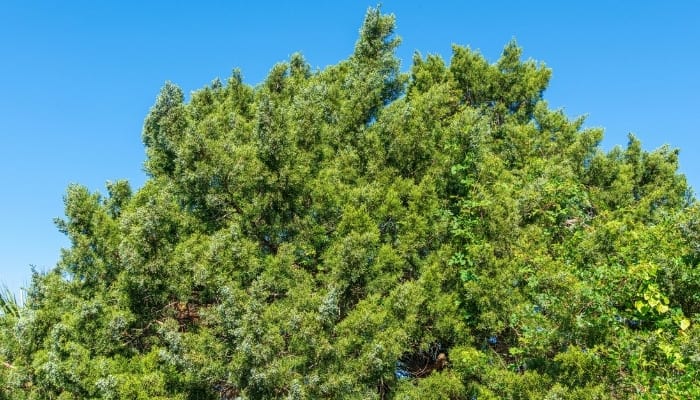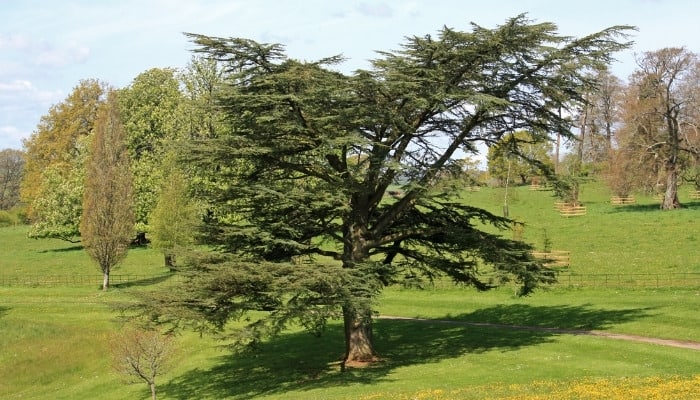The tall cedar trees belonging to the genus Cedrus can grow up to 180 feet in height but require a considerable amount of time to do so.
Native to the Himalayas and the mountains of the Mediterranean, the tree grows best at high altitudes.
If you’re worried that your cedar tree isn’t growing at the rate you expect, the growing conditions around the tree might be behind this slow growth rate.
How fast do cedar trees grow? In ideal conditions, a cedar tree will grow about 25 inches per year. However, it’s common for cedars to only grow 12 to 15 inches yearly. It largely depends on the variety of cedar and growing conditions. High temperatures can impede growth as well.
Not all cedar varieties grow at the same pace or reach the same height at maturity. Read on to find out how to keep your cedar tree growing at the expected rate.
Cedar Tree Growth Rate
The word “cedar” has been used with many plants, even those that don’t actually belong to the Cedrus genus.
Western red cedar (Thuja plicata) and Eastern red cedar (Juniperus virginiana) are two examples of species that are not even remotely related to cedars despite the confusing name.
That means that unless your tree is a true cedar, it will not have the fast growth rates that you expect. Before you buy the cedar sapling, make sure it’s not a false cedar.
Average Cedar Tree Growth Rate
Once you have planted the cedar tree and its roots are established, you can expect it to grow around 25 inches every year, but that rate is not set in stone.
It’s common to see your cedar growing from 12 to 20 inches per year on average. Even true cedar varieties have varying growth rates.
If two different cedar species are growing in the same spot, one could grow at a 20-inch-per-year pace while the other would take its time growing only 12 inches every year.

Factors That Affect Cedar Tree Growth
A slow-growing cedar is not a cause for concern unless the tree appears to be stunted. In that case, you should look for factors such as air and soil temperature, fertilizer, and watering patterns.
- Temperature: As trees that grow best in the mountains, cedars are used to freezing temperatures in the winter. The cold-hardy cedars have a low tolerance to high temperatures that could lead to their demise.
- Fertilizer: For the cedar to grow at 25 inches a year, it needs constant feeding. Apply a high-nitrogen fertilizer with an 18-8-8 label from the early spring onwards. Water immediately after each application to prevent root burn.
- Water: The young cedar tree needs regular watering. However, you should allow the soil to dry out between irrigations. Mulching can help with water retention, especially in the summer. Make sure the mulch doesn’t touch the trunk.
Growth Rate of Common Cedar Trees
Common Questions About Cedar Trees
Are Cedar Trees Evergreen?
Cedar trees are coniferous evergreen trees with lush foliage that doesn’t change color across seasons.
However, the color of the needle-like leaves varies depending on how thick the resinous layer is that covers them.
Thin resin leads to bright green leaves. If the foliage is bluish-green, that means the leaves are covered with a thick layer of wax.
How Tall Do Cedar Trees Grow?
Cedar trees are giants among other coniferous trees. A true cedar can reach 180 feet tall. However, the average height of the cedar tree is between 60 to 120 feet.
False cedars vary in height depending on their species. Since the cedar tree grows at a rate of 12-24 inches a year on average, it would take the tree many years to reach its maximum height.
How Long Do Cedar Trees Last?
Cedars are known for their longevity. They take years to reach maturity, which means they will live for centuries.
The average lifespan of the true cedar is around 300 years or longer. Some Lebanon cedar trees can live up to 1,000 years.
Where Do Cedar Trees Grow?
True cedar trees (Cedrus genus) grow mainly in the mountains of the Mediterranean as well as the Himalayas. They thrive in high altitudes and are hardy to cold or even freezing conditions.
The species that grow in North America with “cedar” in the title are faux cedars, but they are hardy to Zones 2-9.
True Cedar vs. False Cedar
True cedars are those species that belong to the Cedrus genus. They are not native to North America.
In fact, they only grow in the eastern Mediterranean in the mountains of Lebanon and the Himalayas. They reach heights between 120 and 180 feet and live for hundreds of years. Their cones are barrel-shaped.
False cedars are trees that have nothing to do with the Cedrus genus. Many of the “cedars” that grow in North America are false cedars. They vary in height and growth rate as well as the cones they produce.
How Big Do Cedar Trees Get?
Cedar trees are giants that require a lot of space. They average between 60 to 180 feet tall and around 35 feet wide.
That makes them suitable as border trees and as windbreakers. If you have a small yard, the cedar tree is not the ideal choice to grow.
Do Cedar Trees Have Deep Roots?
For being such tall trees, cedars have relatively shallow root systems. The average depth the roots will reach is between 6 to 8 feet.
Conclusion
Cedar trees grow on average between 12 to 24 inches a year. Make sure they’re well fed and watered to keep them growing at this rate.
True cedars are native to the Himalayas and the eastern regions of the Mediterranean. The “cedars” growing in North America are false cedars.

